Business Transformation is a simple game based on providing clarity of purpose and building the capability to deliver against that clear purpose. It is terribly simple[1] Every organisation needs the leadership capability to inspire transformation and provide that clarity of purpose. Every organisation also needs the transformation delivery capability to execute against that purpose. But what do those capabilities look like? How do you develop them? How do you know if you are Transformation Ready?
Every great achievement in history has had both the clarity of purpose and delivery capability to succeed. JFK wanted a man on the moon within the decade, he had NASA to deliver the dream and central funding to make it happen. Bill Shankly wanted to build Liverpool FC into a bastion of invincibility. He had a Boot Room of coaching talent and the club’s finances at his disposal. Sebastian Coe wanted the London Olympics to be the best ever. He had the Olympic Delivery Authority and Government funding. Every successful transformation is an achievement. Every Transformation exercise needs leadership to provide the mission, the clarity of purpose. Every Transformation exercise needs the Transformation Delivery Capability to be able to deliver that mission.
| Ability to Deliver Transformation = |
| Clarity of Purpose X Capability to Execute |
1. Transformation Leadership Capability
Transformation is not a stand-alone team expected to deliver miracles, change the world or deliver the moon on a stick by the rest of the organisation. Transformation is a capability that exists in all departments and at all levels of an organisation, but it starts at the top. Transformational Leadership in this context means the organisation’s leaders, potentially the COO or CFO, but most likely the CEO. Leading the delivery of transformation on the ground is generally the work of the Transformation Director or Programme Director.
One Transformation-friendly definition of Leadership was provided by Kevin Kruse in 2013: “Leadership is a process of social influence, which maximizes the efforts of others, towards the achievement of a goal.”[2] It follows that a successful Transformational Leadership will champion and drive Transformation. There are seven elements to that leadership, and these are summarized as seven core capabilities of Transformational Leadership.
The seven core capabilities of effective Transformational Leadership
- Vision and Mission. The capability to put in place a clear vision of what the Transformation will achieve. Where it will take the organisation? What opportunities it will address? (or what problems it will solve). This also represents the ability to own and articulate that vision succinctly and then champion that mission
- Cultural Alignment. The capability to align business Transformation with an organisation’s values and beliefs or realign the organisation’s culture to be ready for Transformation. Company values and goals should be recognisable in the Transformation vision or mission statement. The leadership role here is to ensure the traditional parameters of change, i.e. the scope, timing, resources and quality cause the minimum friction with organisational culture
- Strategy Alignment. The capability to integrate Transformation with the organisation’s strategy and direction or realign the organisation’s strategy to encourage Transformation. To provide a clear line of sight from Corporate Strategy goals to Transformation activities and to team and individual objectives
- Commitment. The capability to provide Transformation with the Leadership time, attention and enthusiasm to succeed. Most critically, commitment means providing the financial backing and resources to establish and maintain the Transformation Delivery Capability. Leaders who are committed to Transformation will ensure the appropriate resources and skills are made available to deliver against the vision
- Communications. The capability to communicate the vision, the purpose and continue to engage through the lifetime of the Transformation. Effective leaders will ensure that the transformation is understood by everyone. Effective leaders will ensure individuals know how their efforts contribute to the success of transformation
- Accountability. The capability to be decisive and supportive when required to ensure the Transformation can deliver to schedule. Transformation is not an approve and forget exercise. Effective leaders are continuously active, unblocking constraints, resolving issues, delivering on resource commitments
- Inspiration. The least tangible of leadership capabilities is to be able to inspire Transformation teams. Whether it comes from trust, confidence, humility, empowerment, insight or action, an effective leader will be a champion for change and a figurehead for Transformation
Each core capability is a component of an organisation’s Transformation Leadership Capability. That capability can be measured from zero to five, from no leadership to inspirational leadership. Each level brings with it a greater capability to drive Transformation.
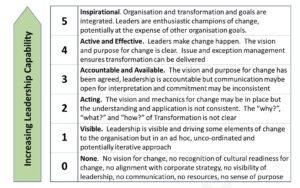
Figure 1: Transformation Leadership Capability – Model Summary
2. Transformation Delivery Capability
The ability to deliver transformation or change is a more tangible concept than leadership but often a more contentious subject. Few people disagree on the basics though: dedicated change professionals are required, a recognised form of delivery governance is a pre-requisite, governance should be applied consistently and include transformation staples like change control, planning, and risk management. In order to measure this capability, it must first be defined:
- The ten core capabilities of Transformation Delivery
- Delivery Leadership. The capability of the Transformation / Programme Director to build and lead both a team of change professionals and the wider organisation to deliver against a clear vision
- Strategy Alignment. The capability to develop the Transformation vision and mission into clear outcomes, delivery approaches, principles and objectives for the organisation to work to. An effective Transformation programme will have a clear line of sight between individual work packages and the corporate strategy they support
- Design. The capability to create, define and communicate the future state or Target Operating Model that the Transformation is delivering to. The capability to manage and control change throughout the process across all business processes, IT and people-based change
- Planning. The capability to build and manage the delivery plan including all constraints, resource availability, all dependencies and all changes through the delivery lifecycle
- Customer. The capability to maintain focus on the end customer that ultimately benefits from the Transformation. The capability to ensure each piece of work keeps in mind what the Transformation is trying to achieve for the customer, client or citizen
- Governance. The capability to implement a single cohesive approach to transformation delivery. The capability to select the right approach, be it flexible or rigid, with defined accountability and responsibility for all initiatives. Everyone must be clear on the approaches to decision making, the management of issues, risks, assumptions and dependencies, resource management and reporting as a minimum. The approach must also be clear at portfolio, programme, project and delivery level.
- Resource. The capability to build and structure the right delivery team. To put in place an effective and transparent temporary organisation that the organisation can work with effectively. The capability to recruit and blend the right individual skills from Programme Management Office (PMO) to business analysis and from project to programme management
- Commercial. The capability to maintain the commercial value of the Transformation, to ensure the Transformation is value led. The capability to manage the cost of Transformation vs. defined benefits. To be able to demonstrate the financial, commercial and intangible benefits being delivered
- Change. The capability to work with all stakeholders and engage the business to deliver Transformation. The capability to communicate and prepare all stakeholders for change, customers, staff, suppliers, business owners and the Transformation team
- Embedding. The capability to deliver Transformation that becomes part of the organisation. The capability to embed changes within an organisation that can be built on with a culture of continuous improvement, not rolled back and shelved
Each core capability is a component of an organisation’s Transformation Delivery Capability. Each level brings with it a greater capability to deliver Transformation.
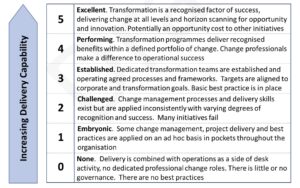
Figure 2: Transformation Delivery Capability – Model Summary
Once a Transformation Leadership and a Transformation Delivery has been reviewed, it is possible to visualise an organisation’s Transformation Capability. The probability of Transformation success is then clearer (Transformation Readiness) and actions can then be taken to improve that probability of success.
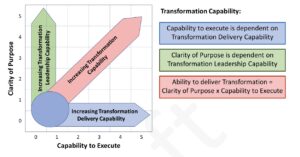
Figure 3: Transformation Capability – the product of Leadership and Delivery Capability
3. Transformation Capability Mapping for Organisations
Being able to measure Transformation Leadership Capability and Transformation Delivery enables a capability assessment to be completed for overall Transformation Capability. Mapping that Transformation Capability reveals 10 different states, ten different zones of readiness:
3.1 Chaos
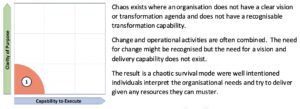
3.2 Futility and Frustration
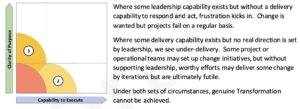
3.3 Mutiny, Exodus and Folly
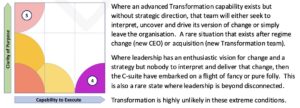
3.4 Detached and Rudderless
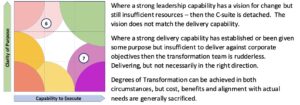
3.5 Conflict – The Flying Squirrel or Doom
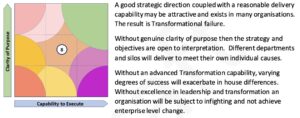
3.6 Over Bombing
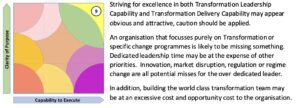
3.7 Goldilocks Zone
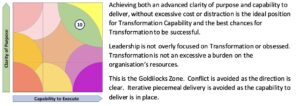
4. Applying the Transformation Capability Assessment
An assessment of Transformation Leadership Capability is useful as a stand-alone exercise. Improvements can be made, behaviours can be addressed consciously, communications tools can be deployed. Equally, an assessment of Transformation Delivery Capability can highlight both quick improvements and strategic changes that can improve delivery success rates.
Real value comes in considering Transformation Leadership vs. Delivery Capability. In doing so behaviours, situations, successes and failures become easier to understand and act on.
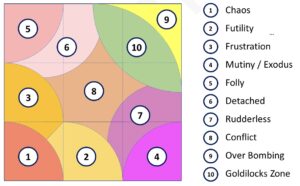
Figure 4: The ten states of Transformation Readiness
4.1 From Detached (6) to Delivery (10)
What does Detached look and feel like? Five things you may be seeing and experiencing in this situation:
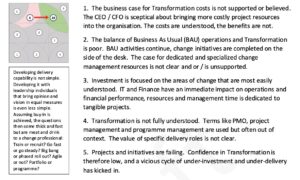
4.2 Potential solutions – moving from Detached (6) to Delivery (10)
Building delivery capability is not complex. Achieving the buy-in required to make that investment is. Several approaches can potentially be deployed to be able to tackle Transformation Delivery Capability and then move to a more successful Transformation environment:
- Develop and communicate the business case. Transformation must be value led. Any project not adding value to the organisation and in line with the strategy must be culled. The business case is the tool to do this. The costs will be clear. Develop the benefits, have them validated, ensure they are tied to milestones and scheduled, communicate each as they are delivered.
- Educate the organisation. Project and programme management are not dark arts. The organisation should understand what happens with and without an effective PMO in place. Better still, harness the delivery capabilities in the organisation. Train, coach and mentor them to deliver.
- Benchmark the organisation. If a main competitor can deliver visible change then benchmark their dedicated change teams. What skills do they have? What roles do they have? How much is that team and what is their burn rate?
- Pilots and quick wins. Start small, deliver value quickly. Demonstrate the approaches taken, from planning through to stakeholder management. Demonstrate and celebrate the benefits delivered to the organisation.
- Share the journey. Start from the vision and work backwards. What are the mileposts along the way to achieving the vision? Tie those to delivery milestones and show step by step delivery of the organisations vision. Put the CEO and the TD on the same path.
4.3 From Rudderless (7) to Delivery (10)
What does Rudderless look and feel like? Five things you may be seeing and experiencing in this situation:
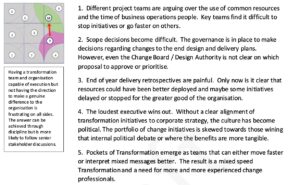
4.4 Potential solutions – moving from Rudderless (7) to Delivery (10)
A rudderless transformation may look effective in places but be running fast in the wrong direction. Conversely progress may be painfully slow as time is taken to prioritise work and gain key decisions. Resolving both situations requires some skills. Here are five ideas to pursue:
- Clear line of sight. In the absence of a connection between the corporate strategy and a portfolio of change initiatives, it’s always possible to propose one. This can be achieved in layers and mean the creation of an operational strategy first to pin projects against.
- CEO education and intervention. Not necessarily the CEO, but if the right sponsor is equipped with the context and expected results for given Transformation initiatives then clear direction and decisions can follow.
- Business case logic. If the benefits case for each project / programme can be defined, then the emotion can be removed from the decision making. This allows the right forums to focus on if / then statements and reduces the discussion and misinterpretation.
- Transformation led delivery. In the absence of clear direction then Transformation / Programme Director is often the best placed neutral and value led individual to lead an executive team through the decision-making process or setting the direction.
- Process led delivery. Although clunky and potentially slow, forcing an organisation to adhere to set rules around engagement, delivery and decision making provides some clarity for the delivery team and enables clear and transparent decisions to be escalated.
4.5 From Conflict (8) to Delivery (10)
Average capability is not OK. An organisation that believes some direction is good enough (potentially under the banner of “empowerment”) will struggle to deliver Transformation. An organisation that believes that average delivery capability is either fit for purpose or all it can afford will not deliver Transformation. Combine the two and the resulting conflict will generate stagnation. Working in this zone is generally painful and counterproductive. Here are five things you may be experiencing:
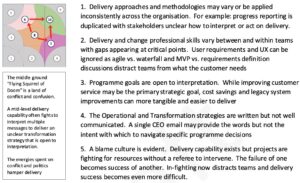
4.6 Potential solutions – moving from Conflict (8) to Delivery (10)
Few scenarios can impact productivity in an organisation greater than blame, internal conflict and politics. Some organisations will see this as normal but change professionals will always see the absence of a clarity of purpose as abnormal and the average delivery capability as a problem. Resolving the situation can difficult. It may be easier to address either leadership or delivery capability first rather than fighting on all fronts. Here are five ideas to pursue:
- Focus on Transformation Delivery Capability. Ensure all basic elements are consistent starting with Governance. Deploy a single governance structure across the organisation (business and IT), ensure a single methodology with tools, templates and systems is used and understood
- Focus on delivery skills. Coach, mentor, recruit the right skills into the Transformation in the right places. The capability to adapt and deliver in any circumstances requires skills and change experience. Build the team ethic to deliver in a challenging environment
- Focus on Transformation Leadership Capability. Educate, coach and show what good looks like. This can include examples of good communication. This can include examples of clear decision making and objective setting.
- Create the Clarity of Purpose. Should the direction and clarity of purpose not come from the expected places, then develop the clearest interpretation and circulate that for validation and use by the transformation teams.
- Hit the reset button. Set up a Transformation / Programme Healthcheck uncover what is really happening, what the leadership and delivery capability actually is and what the recommendations for improvements are. A third party would be useful here to provide an independent view, especially with any politics in play
6. Summary and Conclusions
Business transformations can be among the most complex and rewarding challenges that any organisation or individual will ever experience. However, the capabilities that enable a transformation to succeed are not complicated and, at a strategic level, they are not new.
Despite many efforts to reinvent and rebadge the fundamentals of Transformation, they remain the same. Leaders must inspire, commit, be accountable and provide that clarity of purpose. Transformation Delivery Capability must be built to succeed with the appropriate design, planning, resources and governance.
When the commodities of Transformation Leadership Capability and Transformation Delivery Capability are understood it is possible to recognise an organisation’s Transformation Readiness. It is then possible to understand the reasons for transformation success and failure and to make improvements in capabilities.
When both leadership and delivery can be put together to achieve both a clarity of purpose and a capability to deliver against that clear purpose, then Business Transformation can become terribly simple.
[1] This line is of course inspired by Shanks, who said:
“Football is a simple game based on the giving and taking of passes, of controlling the ball and of making yourself available to receive a pass. It is terribly simple.” Bill Shankly – the man who Transformed Liverpool FC
[2] Kevin Kruse, 2013, “What is Leadership?”
Article by channel:
Everything you need to know about Digital Transformation
The best articles, news and events direct to your inbox
Read more articles tagged: Change & Transformation, Leadership






